Photophosphorylation - Study guides, Revision notes & Summaries
Looking for the best study guides, study notes and summaries about Photophosphorylation? On this page you'll find 458 study documents about Photophosphorylation.
Page 4 out of 458 results
Sort by
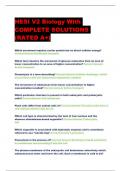
-
HESI V2 Biology With COMPLETE SOLUTIONS (RATED A+)
- Exam (elaborations) • 23 pages • 2023
- Available in package deal
-
- £12.09
- + learn more
HESI V2 Biology With COMPLETE SOLUTIONS (RATED A+) Which movement requires carrier protein but no direct cellular energy? Correct AnswerFacilitated transport Which term denotes the movement of glucose molecules from an area of lower concentration to an area of higher concentration? Correct Answer Active transport Plasmolysis is a term describing? Correct Answer Cellular shrinkage, which occurswhen cells are immersed in hypertonic solution The movement of substances from lesser conc...
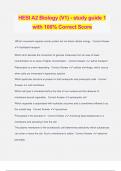
-
HESI A2 Biology (V1) - study guide 1 with 100% Correct Score
- Exam (elaborations) • 7 pages • 2024
- Available in package deal
-
- £8.85
- + learn more
HESI A2 Biology (V1) - study guide 1 with 100% Correct Score Which movement requires carrier protein but not direct cellular energy - Correct Answer ️️ -facilitated transport Which term denotes the movement of glucose molecules from an area of lower concentration to an area of higher concentration - Correct Answer ️️ -active transport Plasmolysis is a term describing - Correct Answer ️️ -cellular shrinkage, which occurs when cells are immersed in hypertonic solution Which par...

-
BIOD 171 Portage Learning FINAL EXAM QUESTIONS AND ANSWERS
- Exam (elaborations) • 7 pages • 2024
-
- £8.85
- + learn more
BIOD 171 Portage Learning FINAL EXAM QUESTIONS AND ANSWERS Which of the following are considered Protista? Select all that apply Bacteria Ameoba Algae Yeast - Answer-Ameoba , Algae True or False. A defining characteristic of Protista is the inability of colonies to form tissue layers - Answer-True The function of a Ribosome is (select all that apply) - Answer-Protein Synthesis Identify the following cellular components by matching the number with the description. - Answer-1. Nucleus ...
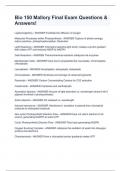
-
Bio 150 Mallory Final Exam Questions & Answers!
- Exam (elaborations) • 7 pages • 2024
- Available in package deal
-
- £10.39
- + learn more
Leghemoglobins - ANSWER Facilitate the diffusion of oxygen Molecular Processes within Photosynthesis - ANSWER Capture of photon energy, redox reactions, photophosphorylation, Reduction Light Reactions - ANSWER Chlorophyl absorbs light which creates a proton gradient that makes ATP and reduces NADP to NADPH Dark Reactions - ANSWER Thermochemical reactions catalyzed via enzymes Meristematic Cells - ANSWER Give rise to proplastids like: leucoplats, chromoplasts, chloroplasts Leucopla...
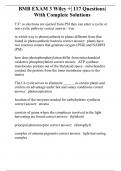
-
BMB EXAM 3 Wiley +| 117 Questions| With Complete Solutions
- Exam (elaborations) • 16 pages • 2023
- Available in package deal
-
- £10.01
- + learn more
T/F: as electrons are ejected from PSI they can enter a cyclic or non-cyclic pathway correct answer: true in which way is photosynthesis in plants different from that found in photosynthetic bacteria correct answer: plants have two reaction centers that generate oxygen (PSII) and NADPH (PSI) how does photophosphorylation differ from mitochondrial oxidative phosphorylation correct answer: ATP synthase translocates protons out of the thylakoid space - mitochondria conduct the protons from...
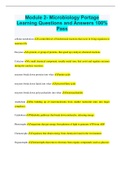
-
Module 2- Microbiology Portage Learning Questions and Answers 100% Pass
- Exam (elaborations) • 7 pages • 2022
- Available in package deal
-
- £7.31
- 1x sold
- + learn more
Module 2- Microbiology Portage Learning Questions and Answers 100% Pass cellular metabolism a controlled set of biochemical reactions that occur in living organisms to maintain life Enzymes a protein, or group of proteins, that speed up (catalyze) chemical reactions Cofactors a small chemical component, usually metal ions, that assist and regulate enzymes during the catalysis reactions. enzymes break down proteins into what: amino acids enzymes break down lipids into what: glycerrol/fatty ac...
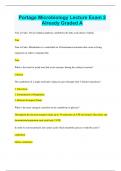
-
Portage Microbiology Lecture Exam 2 Already Graded A
- Exam (elaborations) • 7 pages • 2023
- Available in package deal
-
- £7.70
- + learn more
Portage Microbiology Lecture Exam 2 Already Graded A True or False. The β-oxidation pathway catabolizes the fatty acid chains of lipids. True True or False. Metabolism is a controlled set of biochemical reactions that occur in living organisms in order to maintain life. True What is the term for metal ions that assist enzymes during the catalysis reaction? Cofactor The catabolism of a single molecule of glucose goes through what 3 distinct transitions? 1. Glycolysis 2. Fermentation or Respi...
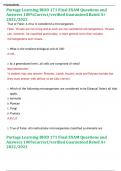
-
Portage Learning BIOD 171 Final EXAM Questions and Answers 100%Correct/verified Guaranteed Rated A+ 2022/2023
- Exam (elaborations) • 51 pages • 2024
-
- £8.85
- + learn more
Portage Learning BIOD 171 Final EXAM Questions and Answers 100%Correct/verified Guaranteed Rated A+ 2022/2023 True or False: A virus is considered a microorganism. False. Viruses are not living and as such are not considered microorganisms. Viruses can, however, be classified asmicrobes, a more general term that includes microorganisms and viruses. 1. What is the smallest biological unit of life? A cell. 2. At a generalized level, all cells are comprised of what? Macromolecules* *A st...
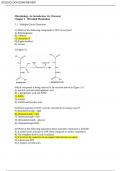
-
OpenStax Microbiology test bank Chapter 5,6,7, and mastering chapter 8
- Exam (elaborations) • 35 pages • 2023
- Available in package deal
-
- £10.39
- + learn more
OpenStax Microbiology test bank Chapter 5,6,7, and mastering chapter 8 1) Which of the following compounds is NOT an enzyme? A) dehydrogenase B) cellulase C) coenzyme A D) β-galactosidase E) sucrase 2) Figure 5.1 Which compound is being reduced in the reaction shown in Figure 5.1? A) isocitric acid and α-ketoglutaric acid B) α-ketoglutaric acid and NAD+ C) NAD+ D) NADH E) NADH and isocitric acid 3) Which organism is NOT correctly matched to its energy source? A) photoheterotrop...

-
Portage Learning BIOD 171 Final EXAM Questions and Answers 100%Correct/verified Guaranteed Rated A+ 2022/2023
- Exam (elaborations) • 83 pages • 2024
-
- £8.85
- + learn more
Portage Learning BIOD 171 Final EXAM Questions and Answers 100%Correct/verified Guaranteed Rated A+ 2022/2023 Portage Learning BIOD 171 Final EXAM Questions and Answers 100%Correct/verified Guaranteed Rated A+ 2022/2023 True or False: A virus is considered a microorganism. False. Viruses are not living and as such are not considered microorganisms. Viruses can, however, be classified as microbes, a more general term that includes microorganisms and viruses. 1. What is the smallest bio...

That summary you just bought made someone very happy. Also get paid weekly? Sell your revision notes on Stuvia! Discover all about earning on Stuvia


